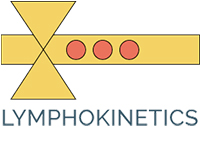Quoted from » Consensus Document of the International Society of Lymphology Executive Committee «
The diagnosis and treatment of peripheral lymphedema
TREATMENT
Therapy of peripheral lymphedema is divided into conservative (non-operative) and operative methods.
Non-operative Treatment
Physical therapy
a. Combination of physical therapies (CPT).
This approach has a long experience and generally involves a two-stage treatment program. The first phase consists of skin care, manual lymphedema treatment (MLT), remedial exercises and compression applied with multi-layered bandage wrapping. Phase 2 (initiated immediately after Phase 1) aims to conserve and optimize the results obtained in Phase 1. It consists of compression by low-stretch elastic stockings or sleeves, skin care, remedial exercises, and repeated MLT as necessary. The basic principle of MLT is that the therapist initiates manual manipulation in the area free of edema bordering proximal to the lymphostatic region, which is treated subsequently in a centrifugal fashion (i.e., most proximal first and distal thereafter).
Indispensable prerequisites of successful combined physiotherapy are the availability of clinical lymphologists, physicians, nurses, and physiotherapists trained specially in this method, acceptance of health insurers to underwrite the cost of treatment, and a biomaterials industry willing to provide high quality products. Compressive bandages can be harmful and/or useless if applied incorrectly. Accordingly, such bandaging should be carried out only by professionally trained personnel.
CPT may also be used for palliation as, for example, to control lymphedema caused by tumor blockage of lymphatics. The treatment is performed in conjunction with chemo- or radiotherapy directed specifically at the tumor. Rare reports suggest that MLT may promote metastatic disease, although theoretically, only diffuse carcinomatous infiltrates which have already spread to lymph collectors as tumor thrombi could be mobilized by mechanical compression. In these instances, the long-term prognosis of the patient is already poor, and some reduction of morbid swelling may be decidedly palliative. Mobilization of dormant tumor cells by arm compression in patients after treatment of carcinoma of the breast remains speculative and thus far unconvincing or unfounded.
A prescription for low stretch garments (custom made with specific measurement as needed) to preserve the results of CPT is essential. It is preferable that a physician be responsible for such garments to avoid inappropriate prescriptions for patients with arterial or deep venous disease. In principle, the highest compression level (usually 40-60 mmHg) tolerated by the patient is likely to be the most beneficial.
Failure of CPT prevails only when intensive treatment in a clinic specializing in management of lymphedema and directed by an experienced clinical lymphologist has been unsuccessful.
b. Intermittent pneumatic compression.
Pneumomassage is usually a two-phase program. After external compression therapy is applied, preferably with a sequential pump, form-fitting elastic stockings or sleeves are necessary to maintain edema reduction. Displacement of edema more proximally in the limb and genitalia and the development of a fibrosclerotic ring at the root of the extremity with further obstruction of lymph flow must be assiduously avoided.
c. Massage alone.
Performed as an isolated technique, classical massage or effleurage usually has minimal benefit. Moreover, if performed overly vigorously, massage may actually injure lymphatic collectors.
d. Wringing out.
«Tuyautage» or wringing out performed with bandages or rubber tubes is now regarded as potentially dangerous and thus obsolete.
e. Thermal therapy.
This technique involves a combination of heat, skin care, and external compression. Although the effectiveness of thermo-therapy has been acclaimed by practitioners in Europe and Japan, as well as China, it should still be considered as under investigation.
f. Elevation.
Simple elevation of a lymphedematous limb reduces swelling primarily in the early stage of lymphedema. If swelling has been reduced by antigravimetric means, the effect should be maintained by low-stretch stockings.
